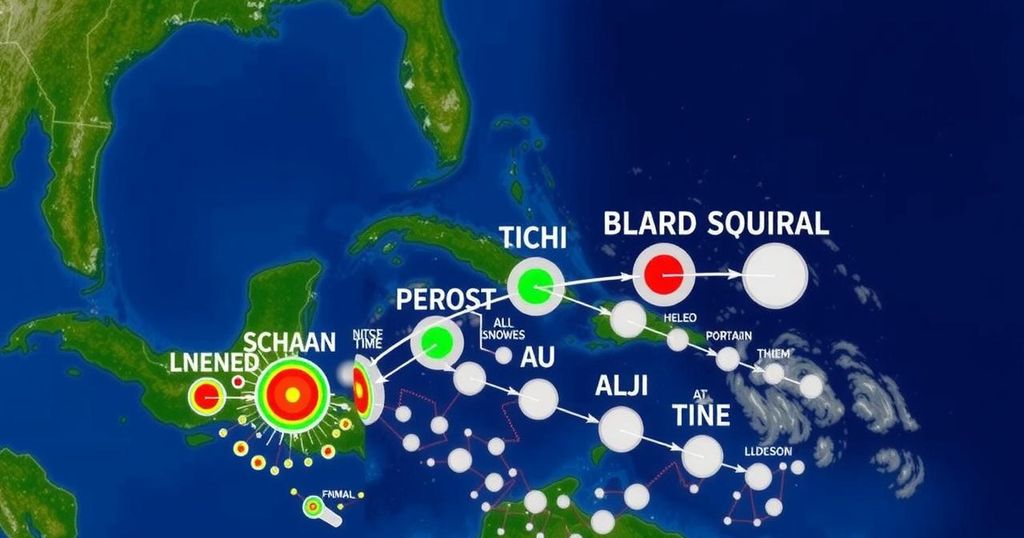Weather
World news
ACCUWEATHER, ASIA, ATLANTIC, BRIAN MCNOLDY, CELESTE SAULO, COLOMBIA, EVACUATIONS, FLA, GULF OF MEXICO, HONDURAS, HURRICANE, HURRICANE BERYL, MATAGORDA, MEXICO, NATURAL DISASTER, NATURAL DISASTERS, NORTH AMERICA, OF MIAMI, PALM BEACH, PHILIPPINES, POST, PUERTO RICO, SARA, SOUTH AMERICA, STEINHATCHEE, TEXAS, TOM KINES, UNITED STATES, UNIVERSITY, UNIVERSITY OF MIAMI, UP, YUCATAN
Daniel O'Connor
0 Comments
Overview of the 2024 Hurricane Season: Notable Storms and Climate Implications
The 2024 hurricane season ended with 18 named storms, including 11 hurricanes and five major ones. Noteworthy storms included Hurricane Beryl, which rapidly intensified to Category 5. Despite the high storm count, improved warning systems reduced fatalities. The season highlights ongoing climatic challenges impacting storm behavior and necessitates continued research and preparedness in disaster management.
The 2024 hurricane season concluded with significant activity in the Atlantic, registering 18 named storms, including 11 hurricanes, of which five were classified as major hurricanes of Category 3 or higher. This season diverged from typical patterns observed in previous years, demonstrating unusual storm behavior, as noted by meteorologists. The most intense storm, Hurricane Beryl, remarkably intensified to Category 5 in record time but ultimately resulted in fewer fatalities due to improved early warning systems. The season, which began on June 1 and ended with the dissipation of Tropical Storm Sara on November 18, was marked by notable destruction but also significant advancements in hurricane monitoring and response strategies.
In addition to Atlantic storms, the Pacific recorded 11 named storms, featuring four hurricanes and two major hurricanes. The 2024 season reflects ongoing concerns regarding climate change’s impact on storm frequency and intensity, as evidenced by the highest number of named storms since 2020, which saw an unprecedented 30 storms.
The conclusion of the hurricane season reiterates the importance of continued research and adaptation strategies in the face of changing climatic conditions, which are likely to influence future seasons.
Effective management of destruction and maintaining updated emergency preparedness systems are essential as scientists continue to study the evolving nature of tropical cyclones and their implications for global weather systems.
Understanding hurricane seasons is critical given their potential for devastation and the socio-economic repercussions they entail. The Atlantic hurricane season typically runs from June 1 to November 30, marked by the development of named storms that can lead to destructive hurricanes. The 2024 season has raised eyebrows due to its unusual characteristics and storm behaviors, indicating a potential linkage to broader climatic shifts. Enhancements in early warning systems have played a significant role in reducing fatalities compared to previous seasons, emphasizing the need for continued investment in technology and preparedness protocols. The Pacific hurricane season similarly highlighted shifts in storm activity, underlining a trend towards more dynamically active seasons influenced by global climate conditions.
The 2024 hurricane season has left an indelible mark with 18 named storms and 11 hurricanes, showcasing significant variability and unpredictable storm patterns. While the season brought about considerable damage exceeding $1 billion due to four major hurricanes, life-saving advancements in warning systems proved effective in minimizing fatalities. Climate change continues to reshape the landscape for tropical cyclones, necessitating ongoing research and preparedness. As we move forward, the lessons learned from this season will be vital in crafting adaptive strategies for managing future weather-related challenges.
Original Source: www.upi.com




Post Comment